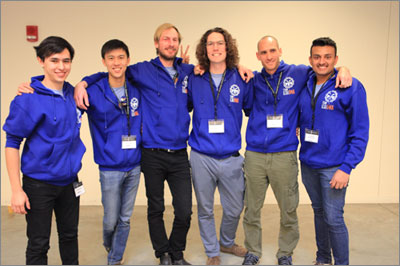Attracting student competitors from North America, Europe, Asia and Australia, the Wyss Institute’s fourth annual BIOMOD Competition was held this past weekend at Harvard University in Cambridge. Launched by the Wyss Institute for Biologically Inspired Engineering in 2011 with the goal of introducing the next generation of scientists and engineers to bionanotechnology, BIOMOD this year drew its largest crowd yet of 250 competitors comprising 30 teams from 12 countries.
Grand prize winner “Team echiDNA” from Australia’s Victor Chang Cardiac Research Institute was recognized for presenting its cooperative molecular biosensor, which was inspired by swarming behavior seen throughout Nature in flocks of birds, schools of fish, swarms of insects, and multicellular mechanisms in the human body.
The winning team kicked off its presentation by triggering the entire audience to participate in “The Wave”, which is accomplished when a large crowd of people raises arms in synchrony with their neighbors, starting from one side of the crowd and moving across the group. “The Wave” across the BIOMOD audience made for an effective demonstration of how swarm behavior is successful when neighboring organisms transmit and interpret signals among one another.

Competing teams presented their biologically inspired designs to a crowd full of fellow competitors and a panel of BIOMOD judges, made up of faculty and experts in bionanotechnology, including Wyss Institute Core Faculty Members William Shih, Ph.D., and Peng Yin, Ph.D.
The interest in BIOMOD has grown so rapidly that Ohio State University, which has participated three years in a row, for the first time implemented a selection process to decide which students would fill seven spots on the team.
“There was such great demand to join the team that we asked students to write a short abstract about what they proposed to use as a BIOMOD project,” said Chris Lucas, a biomedical science and immunology post-doctoral mentor to the OSU “OhioMOD” team. “We selected the authors of the most compelling abstracts – with an efficient team of seven members, each student had ownership of a different project component.”
All competing BIOMOD teams were evaluated by the panel of judges using criteria such as technical benchmarks and potential for translation. Runners up for the Grand Prize were the German and Japanese teams “Dresden DNAmic” and “Sendai”, hailing from Dresden University of Technology and Tohoku University, respectively. First runners-up “Dresden DNAmic” presented a plasmonic waveguide that utilized DNA origami to construct gold nanoparticles into precise formation for optimal light transmission. Second runners-up “Sendai” presented a programmable, scalable universal strand generator that uses enzymes and DNA to eliminate sequential pipetting methods.
Many teams zeroed in on designs that had potential for real-world impact in treating health conditions and disease. A Chinese team from Huazong University of Science and Technology presented a steerable magnetic “nano-ship” to target cancer cells and deliver drugs using a gold nanoparticle as a guide, Canadian competitors from University of Calgary presented a method for trapping, manipulating and report DNA presence at single molecule quantities, and students from India’s BMS College of Engineering showcased a drug delivery system they named “Sampoorna Surakshan”, which translates to “Complete Protection” and uses precise protein fusion to only have effect on targeted disease-causing cells while avoiding impact on harmless cells nearby.
The competition, which started out with 100 competitors its first year in 2011, gives up and coming young scientists a realistic idea of what it takes to succeed in research.
“I think many professions, including scientific research, are very abstract until you actually try them,” said Shawn Douglas, Ph.D., current Assistant Professor at University of California San Francisco’s Department of Cellular Molecular Pharmacology, former Technology Development Fellow at the Wyss Institute, and the founder of BIOMOD. “Research can be fraught with failures and setbacks, but can also be very rewarding. My hope is that BIOMOD gives students a taste of what it’s like to overcome hurdles to eventually create something new in the lab, and then share those ideas and results with other people in the world.”
And by the looks of it, BIOMOD is already having a positive preparatory effect on bionanotechnology’s future leaders.
“Recently, I’ve begun to hear from other professors around the world that they are seeing graduate school applicants with ‘BIOMOD’ listed on their resumes,” said Douglas.